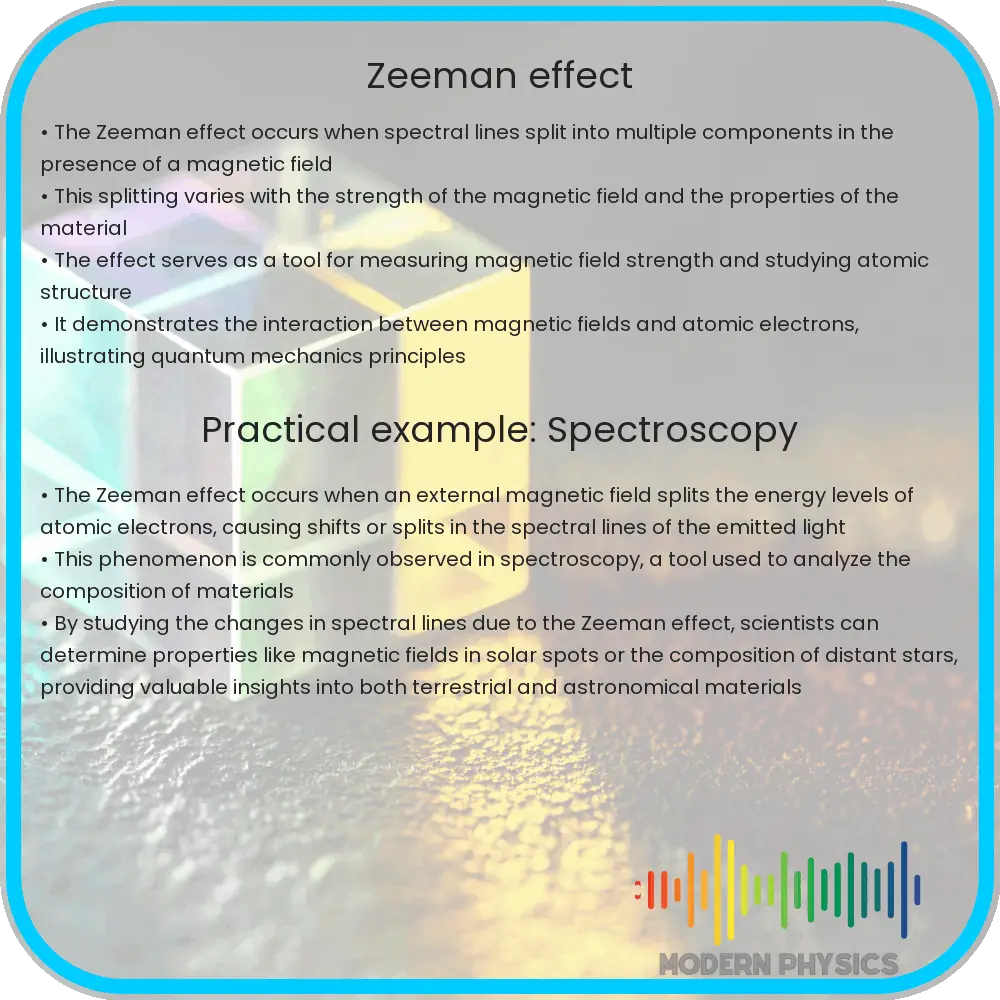Learn about the Zeeman Effect, a phenomenon where spectral lines split in a magnetic field, affirming quantized electron momentum and advancing quantum mechanics.

Understanding the Zeeman Effect
The Zeeman Effect is a fascinating phenomenon in physics where the spectral lines emitted by atoms split into multiple components in the presence of a magnetic field. First discovered by the Dutch physicist Pieter Zeeman in 1896, this effect not only deepened our understanding of the quantum world but also affirmed the quantized nature of the electron’s orbital angular momentum—effectively marking a significant milestone in the development of quantum mechanics.
Explanation of the Zeeman Effect
At the atomic level, electrons orbit around the nucleus, and each of these orbits have a specific amount of angular momentum and energy, quantized in discrete levels. When an external magnetic field is applied, these energy levels split due to the interaction between the magnetic field and the magnetic dipole moment associated with the angular momentum of the electrons.
This splitting occurs because the magnetic field exerts an additional force on the magnetic moments of the electrons, aligning or opposing their spins and orbital angular momentum. Depending on the direction of the electron’s magnetic moment in relation to the magnetic field, the energy level of the electron can increase or decrease. This results in the atomic emission or absorption lines being split into multiple components, each corresponding to different alignments.
Mathematical Description of the Zeeman Effect
The energy shift, ΔE, that results from the Zeeman Effect can be approximated by the formula:
ΔE = μB B ml
where μB is the Bohr magneton, B is the magnetic flux density, and ml is the magnetic quantum number, which can take values from -l to +l, where l is the orbital quantum number of the given electron state.
The precise impact of the magnetic field on spectral lines can further be classified into two types based on the electron configurations and external magnetic field strength:
- Normal Zeeman Effect: This occurs when the spectral lines are split into three components (triplet) – one central component with the original wavelength and two symmetrically spaced components on either side, observable typically in scenarios involving weaker magnetic fields and s-states (where the spin quantum number is zero).
- Anomalous Zeeman Effect: This occurs in most other cases where the splitting results in more than three components, accounted for by additional configurations in quantum spin states.
Impact of the Zeeman Effect
The discovery and subsequent investigation of the Zeeman Effect had profound implications in physics. It played a crucial role in the experimental understanding of quantum mechanics and the underlying principles of electron configurations. The phenomenon is pivotal in the field of spectroscopy, aiding the analysis of the elemental and isotopic composition of materials.
Further, understanding the Zeeman Effect helped in enhancing the model of the atom, leading to more accurate predictions about the behavior of electrons under various external influences. The ability to manipulate and measure the attributes of electrons through external magnetic fields has been crucial in developing various technologies and understanding different astrophysical phenomena.
Uses of the Zeeman Effect
The practical applications of the Zeeman Effect are vast and varied. Some of the most significant include:
- Magnetic field measurement: The Zeeman Effect is utilized in spectroscopic tools for measuring magnetic fields, which is especially useful in remote sensing applications in astrophysics and various industrial applications.
- Study of Solar and Stellar Magnetic Fields: The effect is instrumental in probing the magnetic fields of the Sun and other stars, providing insights into their magnetic properties and behaviors such as solar flares and sunspots.
Conclusion
The Zeeman Effect showcases a profound intersection of magnetic fields with quantum mechanical phenomena, underscoring the nuanced relationships within atomic structures. By studying how these atomic spectral lines split in the presence of magnetic fields, scientists gain insights not only into the properties of elements but also into the broader mechanisms governing the universe. From providing critical data in astrophysics to enhancing everyday technologies, the understanding and application of the Zeeman Effect continue to offer significant contributions across various scientific disciplines.
In simple terms, the Zeeman Effect helps us to better understand how electrons behave in magnetic fields, enabling advancements in fields like spectroscopy and magnetic resonance imaging (MRI). It also plays a key role in the development of new materials and technologies that depend on precise control of electronic properties. As such, the Zeeman Effect remains a pivotal concept in physics, with its implications observed in both theoretical frameworks and practical applications.
Ultimately, the exploration of such quantum effects furthers our broader quest to decipher the complex tapestry of the universe. Whether you’re a student, a researcher, or simply a curious mind, delving into the study of phenomena like the Zeeman Effect can provide a deeper appreciation of both the natural world and the engineered technologies that utilize these quantum principles.
By continuing to explore and understand such fundamental concepts, we pave the way for future innovations and a deeper connection to the cosmos around us, reinforcing the beauty and precision inherent in the laws of physics.
